Performance Evaluation of Desulfurized Rubber Powder and Styrene-Butadiene-Styrene Composite-Modified Asphalt
Abstract
1. Introduction
- (1)
- To develop an optimal DRP–SBS composite modification method that improves the overall performance of asphalt.
- (2)
- To systematically evaluate the rutting resistance at high temperature, fatigue resistance at medium temperature, thermal cracking resistance at low temperature, and aging resistance of the composite-modified asphalt, compare the results with those of conventional RPA and SBS-modified asphalt, and assess the practical application potential of DRP-SBS composite modification.
2. Materials and Methods
2.1. Raw Materials
2.2. Preparation of Composite-Modified Asphalt
2.3. Experimental Methods
3. Results and Discussion
3.1. Basic Properties of Composite-Modified Asphalt
3.2. Brookfield Viscosity
3.3. Performance Evaluation of Asphalt Binder
3.3.1. Complex Shear Modulus Master Curves
3.3.2. Rutting Resistance Evaluation
3.3.3. Fatigue Resistance Evaluation
3.3.4. Creep and Recovery Evaluation
3.4. Performance Evaluation of Asphalt Mixture
3.4.1. Moisture Susceptibility
3.4.2. High-Temperature Stability
3.4.3. Low-Temperature Cracking Resistance Evaluation
3.4.4. Fatigue Resistance Evaluation
3.4.5. Comparison with Existing Research
4. Conclusions
- (1)
- Compared to conventional rubber powder, DRP significantly reduces the viscosity of rubber-modified asphalt, enhancing its construction workability. The Brookfield viscosity is 1.95 Pa·s, well below the standard limit of 3 Pa·s. The lower viscosity of the composite-modified asphalt permits reduced mixing and paving temperatures, leading to energy savings, lower emissions, and more environmentally friendly construction.
- (2)
- Both DRP and SBS modifiers enhance the high-temperature rheological properties of asphalt. However, asphalt modified with DRP alone exhibits limited ductility, ranging from 7 to 8 cm—below the 10 cm standard. The addition of SBS significantly improves the performance of DRP-modified asphalt, increasing ductility to nearly 14 cm.
- (3)
- Composite-modified asphalt incorporating DRP and SBS demonstrates superior performance in rutting factor, fatigue factor, non-recoverable creep compliance, and creep recovery rate, confirming the study’s hypothesis that combining these two modifiers enhances the overall performance of asphalt binders and meets the technical requirements of JT/T 798-2019. As the contents of DRP and SBS increase, notable improvements are observed in high-temperature rutting resistance, medium-temperature fatigue resistance, and elastic recovery. Compared to asphalt without SBS, the rutting factor at 82 °C increases by 56%, the critical fatigue temperature decreases by 26.7%, and elastic recovery remains above 90%. Based on performance and cost considerations, the optimal formulation was determined to be 25% DRP and 1% SBS.
- (4)
- The continuous gradation-activated rubber powder–SBS composite-modified asphalt mixture exhibits superior moisture stability, low-temperature crack resistance, and fatigue life compared to the discontinuous gradation mixture. Particularly for fatigue performance, its fatigue life is 32.5% longer than that of the rubber powder–SBS composite-modified mixture and 16.2% longer than that of the SBS-modified mixture. Regarding high-temperature stability, for the AC-13 gradation, the composite-modified mixture outperforms both SBS- and conventional rubber-modified mixtures, with DS increases of 6.5% and 18.2%, and flow number improvements of 12.5% and 15.6%, respectively. Under the RAC-13 gradation, DS increases by 9.0% and 2.3%, and flow number increases by 2.5% and 6.3%, respectively.
- (5)
- When the activated rubber powder-SBS modified asphalt is designed with continuous gradation, its oil-to-stone ratio is approximately 9.5% lower than that of the discontinuous gradation, resulting in significant economic benefits.
Author Contributions
Funding
Institutional Review Board Statement
Informed Consent Statement
Data Availability Statement
Conflicts of Interest
Abbreviations
| RPA | Rubber Powder Asphalt |
| DRP | Desulfurized Rubber Powder |
| SBS | Styrene-Butadiene-Styrene |
| COV | Coefficient of Variation |
| DSR | Dynamic Shear Rheometer |
| VTS | Viscosity-Temperature Susceptibility |
| DS | Dynamic Stability |
| UTM | Universal Testing Machine |
References
- Ding, X.; Ma, T.; Zhang, W.; Zhang, D. Experimental study of stable crumb rubber asphalt and asphalt mixture. Constr. Build. Mater. 2017, 157, 975–981. [Google Scholar] [CrossRef]
- Qian, C.; Fan, W. Evaluation and characterization of properties of crumb rubber/SBS modified asphalt. Mater. Chem. Phys. 2020, 253, 123319. [Google Scholar] [CrossRef]
- Xu, O.; Xiao, F.; Han, S.; Amirkhanian, S.N.; Wang, Z. High temperature rheological properties of crumb rubber modified asphalt binders with various modifiers. Constr. Build. Mater. 2016, 112, 49–58. [Google Scholar] [CrossRef]
- Feng, Z.G.; Rao, W.Y.; Chen, C.; Tian, B.; Li, X.J.; Li, P.L.; Guo, Q.L. Performance evaluation of bitumen modified with pyrolysis carbon black made from waste tyres. Constr. Build. Mater. 2016, 111, 495–501. [Google Scholar] [CrossRef]
- Ameli, A.; Babagoli, R.; Aghapour, M. Laboratory evaluation of the effect of reclaimed asphalt pavement on rutting performance of rubberized asphalt mixtures. Pet. Sci. Technol. 2016, 34, 449–453. [Google Scholar] [CrossRef]
- Picado-Santos, L.G.; Capitão, S.D.; Dias, J.L.F. Crumb rubber asphalt mixtures by dry process: Assessment after eight years of use on a low/medium trafficked pavement. Constr. Build. Mater. 2019, 215, 9–21. [Google Scholar] [CrossRef]
- Xiang, L.; Cheng, J.; Que, G. Microstructure and performance of crumb rubber modified asphalt. Constr. Build. Mater. 2009, 23, 3586–3590. [Google Scholar] [CrossRef]
- Ameri, M.; Yazdipanah, F.; Rahimi Yengejeh, A.; Afshin, A. Production temperatures and mechanical performance of rubberized asphalt mixtures modified with two warm mix asphalt (WMA) additives. Mater. Struct. 2020, 53, 1–16. [Google Scholar] [CrossRef]
- Venudharan, V.; Biligiri, K.P.; Sousa, J.B.; Way, G.B. Asphalt-rubber gap-graded mixture design practices: A state-of-the-art research review and future perspective. Road Mater. Pavement Des. 2017, 18, 730–752. [Google Scholar] [CrossRef]
- Liang, M.; Ren, S.; Fan, W.; Wang, H.; Cui, W.; Zhao, P. Characterization of fume composition and rheological properties of asphalt with crumb rubber activated by microwave and TOR. Constr. Build. Mater. 2017, 154, 310–322. [Google Scholar] [CrossRef]
- Liang, M.; Xin, X.; Fan, W.; Ren, S.; Shi, J.; Luo, H. Thermo-stability and aging performance of modified asphalt with crumb rubber activated by microwave and TOR. Mater. Des. 2017, 127, 84–96. [Google Scholar] [CrossRef]
- Sienkiewicz, M.; Borzędowska-Labuda, K.; Wojtkiewicz, A.; Janik, H. Development of methods improving storage stability of bitumen modified with ground tire rubber: A review. Fuel Process. Technol. 2017, 159, 272–279. [Google Scholar] [CrossRef]
- Yu, G.X.; Li, Z.M.; Zhou, X.L.; Li, C.L. Crumb rubber–modified asphalt: Microwave treatment effects. Pet. Sci. Technol. 2011, 29, 411–417. [Google Scholar] [CrossRef]
- Beylergil, B.; Ozturkmen, M.B.; Al-Nadhari, A.; Yildiz, S.; Aydoğan, B.; Yildiz, M. Enhancement of mechanical properties of carbon fiber epoxy composites using methylmethacrylate-butadiene-styrene (MBS) core-shell nanoparticles. J. Compos. Mater. 2025, 00219983251315533. [Google Scholar] [CrossRef]
- Fang, Y.; Zhang, Z.; Zhang, K.; Li, Z. Rheological property evaluation and microreaction mechanism of rubber asphalt, desulfurized rubber asphalt, and their composites. J. Mater. Civ. Eng. 2021, 33, 04021100. [Google Scholar] [CrossRef]
- Zeng, Z.; Sudarsanan, N.; Underwood, B.S.; Kim, Y.R.; Guddati, M. Reflective Cracking Performance Evaluations of Highly Polymer-Modified Asphalt Mixture. J. Transp. Eng. Part B Pavements 2024, 150, 04024039. [Google Scholar] [CrossRef]
- Michler, G.H.; Balta-Calleja, F.J. Nano-and Micromechanics of Polymers: Structure Modification and Improvement of Properties. Carl Hanser Verlag GmbH Co KG: München, Germany, 2012. [Google Scholar]
- JTG F40-2004; Technical Specifications for Construction of Highway Asphalt Pavements. Ministry of Transport of China: Beijing, China, 2004.
- ASTM D7405-20Standard Test Method for Multiple Stress Creep and Recovery (MSCR) of Asphalt Binder Using a Dynamic Shear Rheometer; ASTM: West Conshohocken, PA, USA, 2020.
- Zhang, L.; Xing, C.; Gao, F.; Li, T.S.; Tan, Y.Q. Using DSR and MSCR tests to characterize high temperature performance of different rubber modified asphalt. Constr. Build. Mater. 2016, 127, 466–474. [Google Scholar] [CrossRef]
- Li, P.; Jiang, X.; Ding, Z.; Zhao, J.; Shen, M. Analysis of viscosity and composition properties for crumb rubber modified asphalt. Constr. Build. Mater. 2018, 169, 638–647. [Google Scholar] [CrossRef]
- JT-T-798-2019; Crumb Rubber Asphalt Highway Engineering. Ministry of Transport of China: Beijing, China, 2019.
- Zeng, Z.A.; Underwood, B.S.; Castorena, C. Low-temperature performance grade characterisation of asphalt binder using the dynamic shear rheometer. Int. J. Pavement Eng. 2022, 23, 811–823. [Google Scholar] [CrossRef]
- Gu, L.; Chen, L.; Zhang, W.; Ma, H.; Ma, T. Mesostructural modeling of dynamic modulus and phase angle master curves of rubber modified asphalt mixture. Materials 2019, 12, 1667. [Google Scholar] [CrossRef]
- Liu, X.; Luo, W.; Li, M. A novel approach for constructing master curves of rheological simple material. Chin. J. Solid Mech. 2015, 36, 223–232. [Google Scholar]
- Su, N.; Xiao, F.; Wang, J.; Amirkhanian, S. Precision analysis of sigmoidal master curve model for dynamic modulus of asphalt mixtures. J. Mater. Civ. Eng. 2018, 30, 04018290. [Google Scholar] [CrossRef]
- Liu, Q.; Liu, J.; Yu, B.; Zhang, J.; Pei, J. Evaluation and optimization of asphalt binder and mixture modified with high activated crumb rubber content. Constr. Build. Mater. 2022, 314, 125676. [Google Scholar] [CrossRef]
- Gui, W.; Liang, L.; Wang, L.; Gao, X.; Zhang, F. Performance evaluation of warm-mixed crumb rubber modified asphalt based on rheological characteristics. Constr. Build. Mater. 2021, 285, 122881. [Google Scholar] [CrossRef]
- AASHTO T 315-12; Standard Method of Test for Determining the Rheological Properties of Asphalt Binder Using a Dynamic Shear Rheometer (DSR). American Association of State Highway and Transportation Officials: Washington, DC, USA, 2016.
- Zeng, Z.; Kim, Y.R.; Underwood, B.S.; Guddati, M. Asphalt mixture fatigue damage and failure predictions using the simplified viscoelastic continuum damage (S-VECD) model. Int. J. Fatigue 2023, 174, 107736. [Google Scholar] [CrossRef]
- Zeng, Z.; Underwood, B.S.; Kim, Y.R. A state-of-the-art review of asphalt mixture fracture models to address pavement reflective cracking. Constr. Build. Mater. 2024, 443, 137674. [Google Scholar] [CrossRef]
- Kocak, S.; Kutay, M.E. Effect of devulcanized rubber modification on the performance grade, fatigue cracking resistance, and rutting resistance of asphalt binders. J. Mater. Civ. Eng. 2021, 33, 04021248. [Google Scholar] [CrossRef]
- Hainin, M.R.; Aziz, M.M.A.; Adnan, A.M.; Hassan, N.A.; Jaya, R.P.; Liu, H.Y. Performance of modified asphalt binder with tire rubber powder. J. Teknol. (Sci. Eng.) 2015, 73. [Google Scholar] [CrossRef][Green Version]
- Vavrik, W.R.; Pine, W.J.; Carpenter, S.H. Aggregate blending for asphalt mix design: Bailey method. Transp. Res. Rec. 2002, 1789, 146–153. [Google Scholar] [CrossRef]
- tur Rasool, R.; Song, P.; Wang, S. Thermal analysis on the interactions among asphalt modified with SBS and different degraded tire rubber. Constr. Build. Mater. 2018, 182, 134–143. [Google Scholar] [CrossRef]
- Zhang, F.; Li, J.; Yaseen, M.; Han, M.; Yin, Y.; Yang, S. Preparation methods and performance of modified asphalt using rubber–plastic alloy and its compounds. J. Mater. Civ. Eng. 2018, 30, 04018163. [Google Scholar] [CrossRef]
- Xiang, L.; Wang, Z.G.; Du, Y.; Cheng, J.; Que, G.H. Preparation technology and performance analysis of crumb rubber and sbs composite modified asphalt binder. Adv. Mater. Res. 2011, 160, 1320–1324. [Google Scholar] [CrossRef]
- Elenien, K.F.A.; Abdel-Wahab, A.; ElGamsy, R.; Abdellatif, M.H. Assessment of the properties of PP composite with addition of recycled tire rubber. Ain Shams Eng. J. 2018, 9, 3271–3276. [Google Scholar] [CrossRef]
- Qian, C.; Fan, W.; Liang, M.; He, Y.; Ren, S.; Lv, X.; Nan, G.; Luo, H. Rheological properties, storage stability and morphology of CR/SBS composite modified asphalt by high-cured method. Constr. Build. Mater. 2018, 193, 312–322. [Google Scholar] [CrossRef]
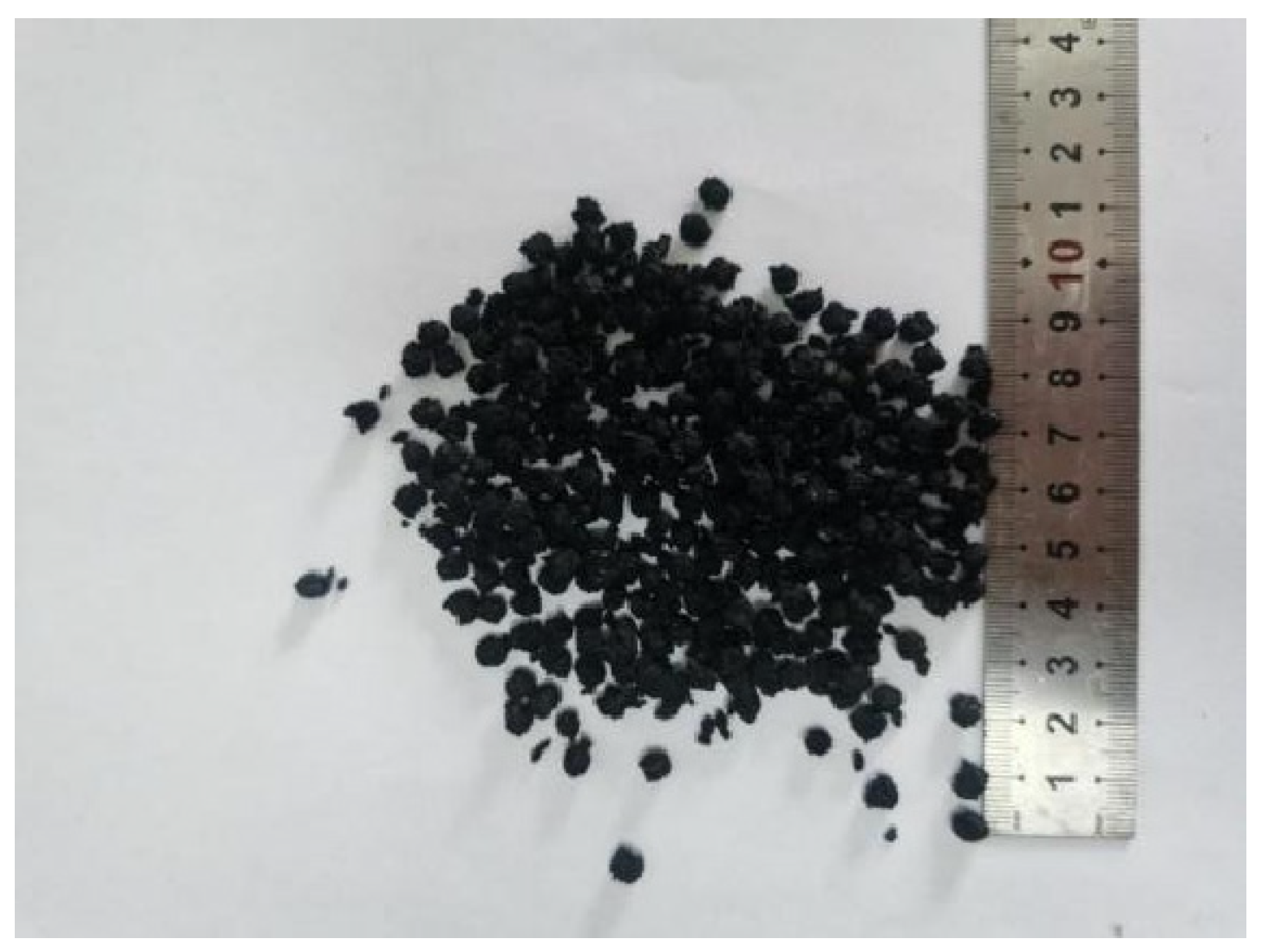


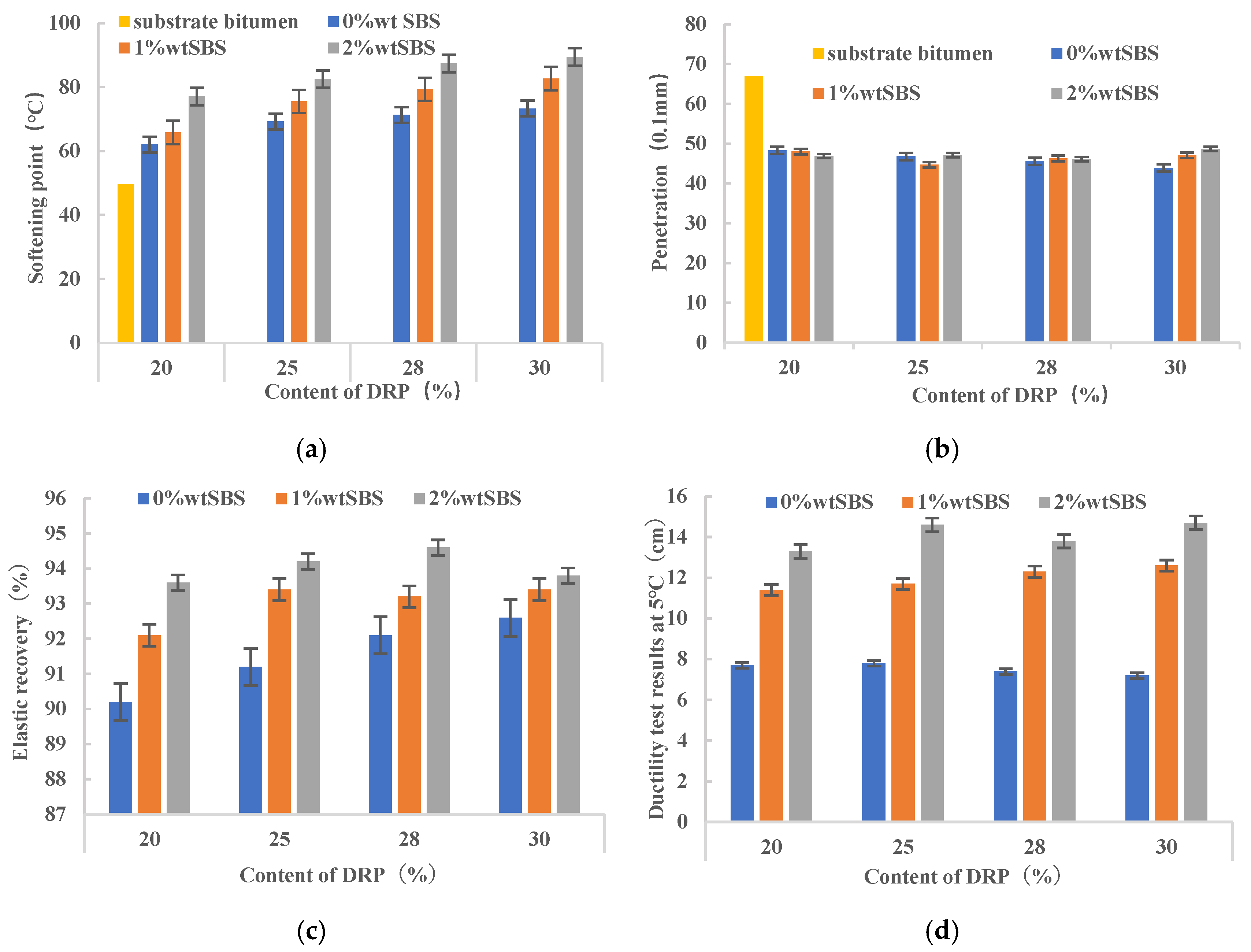
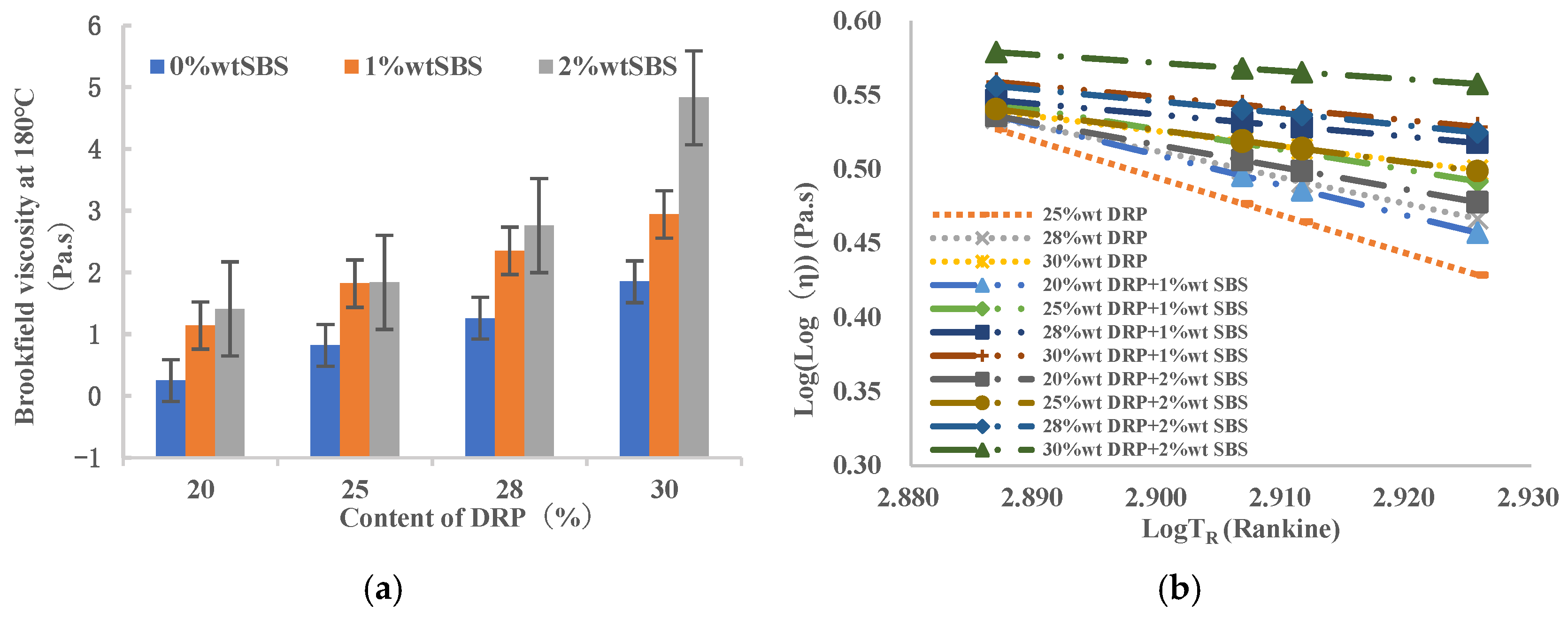

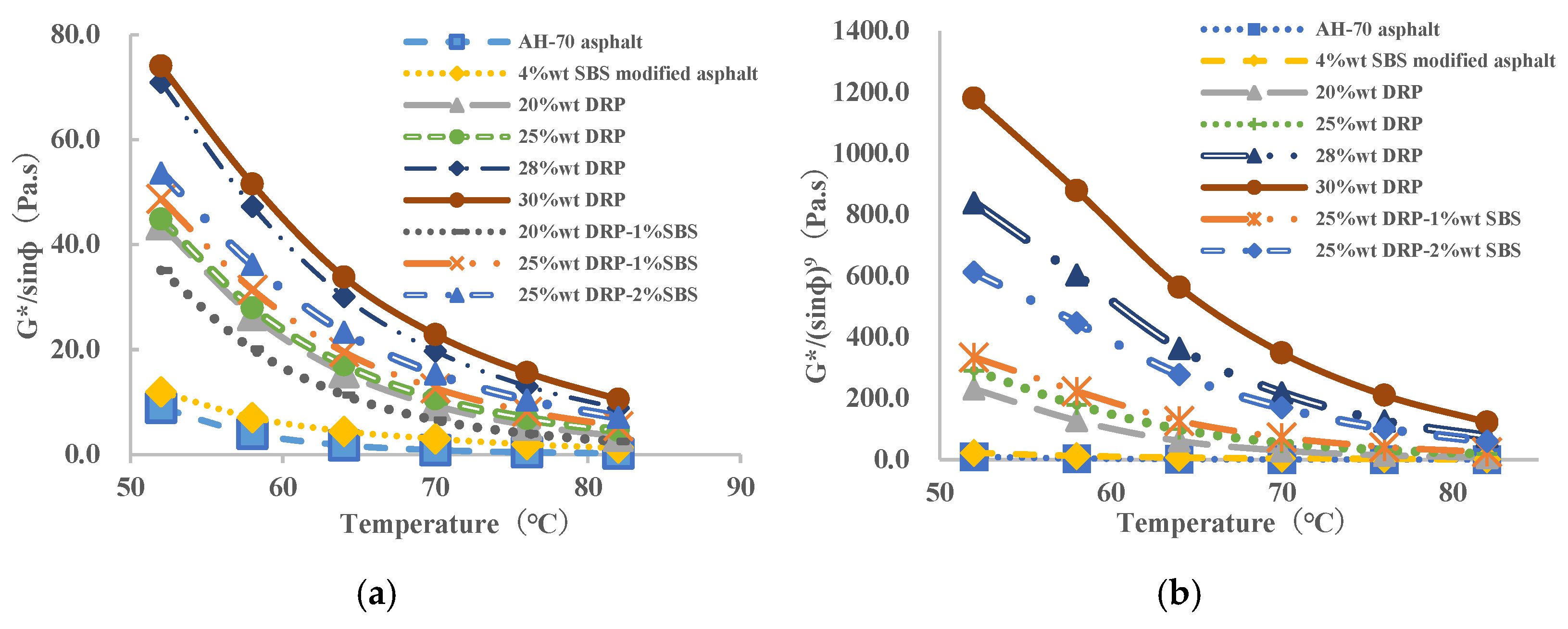
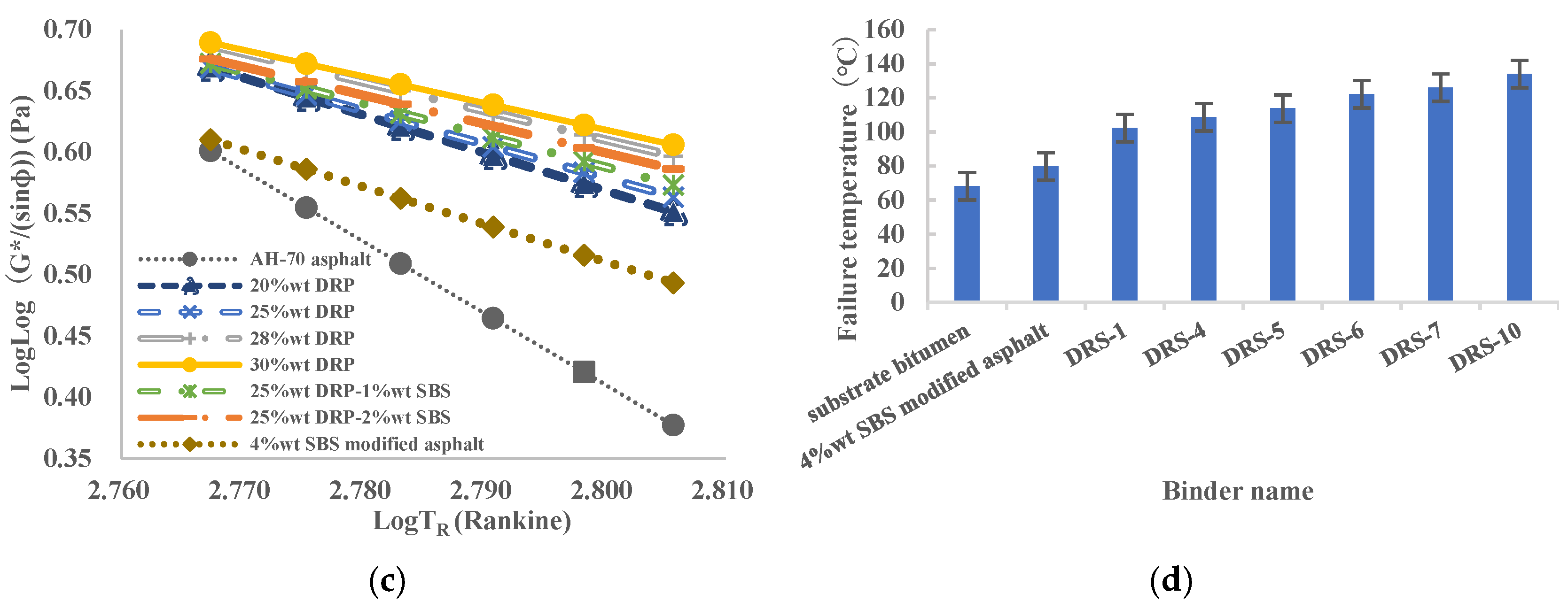
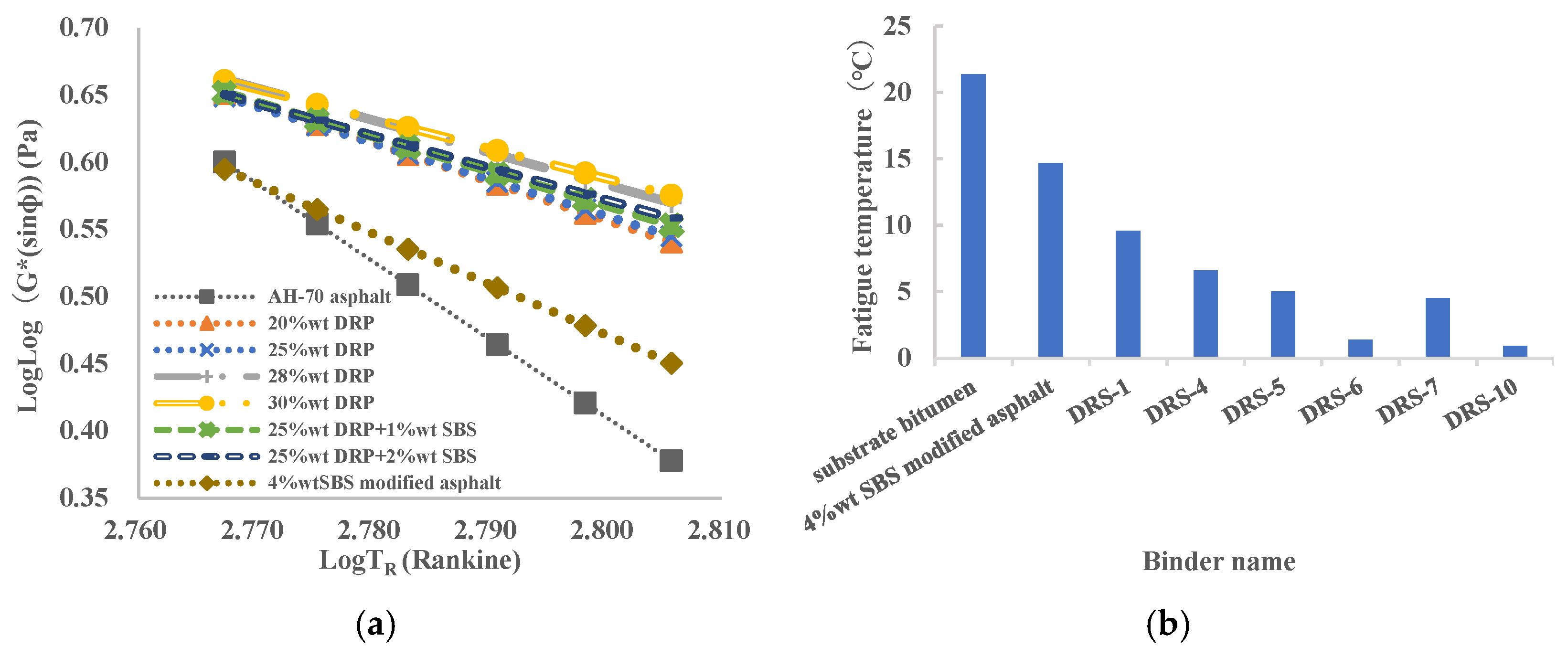
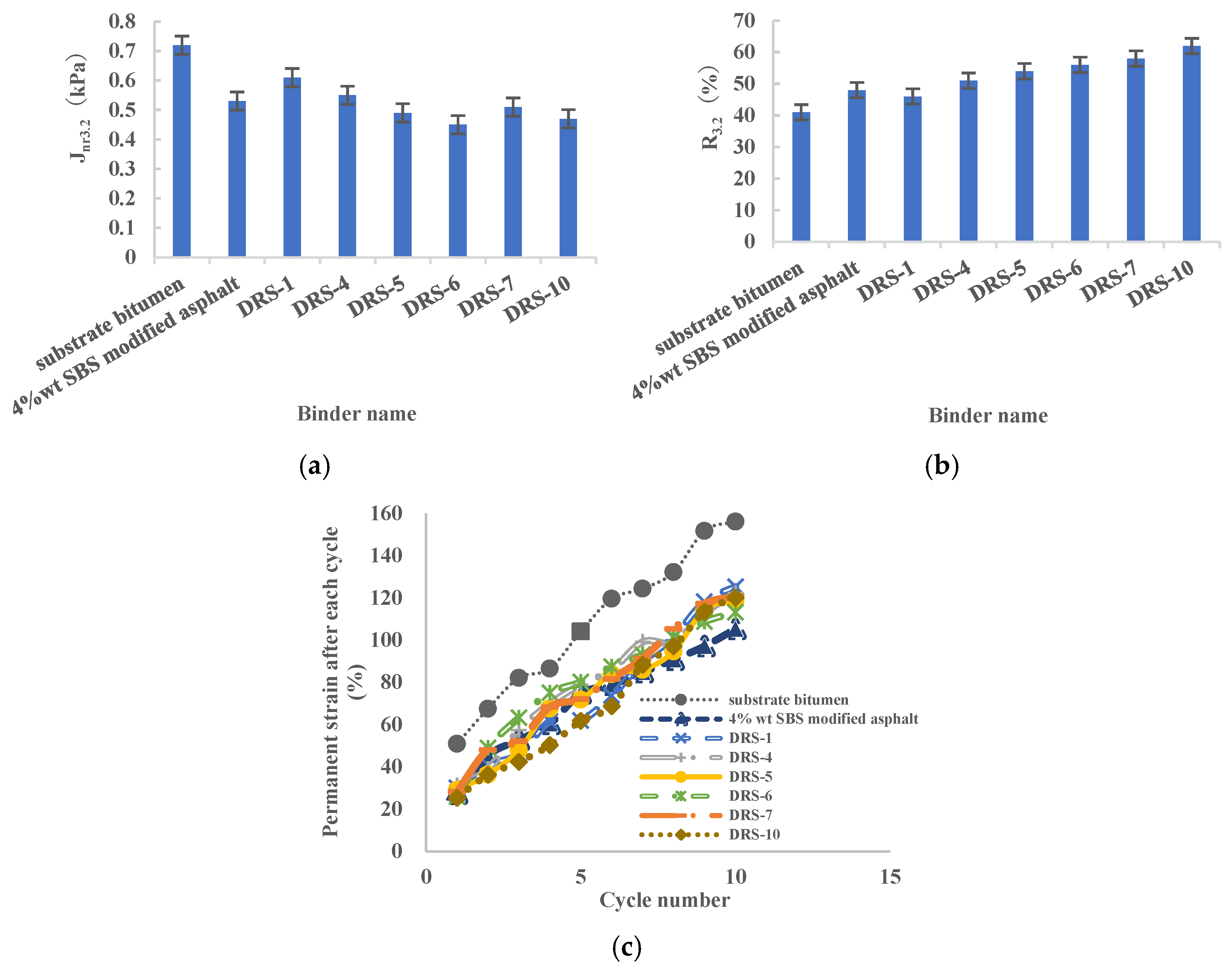

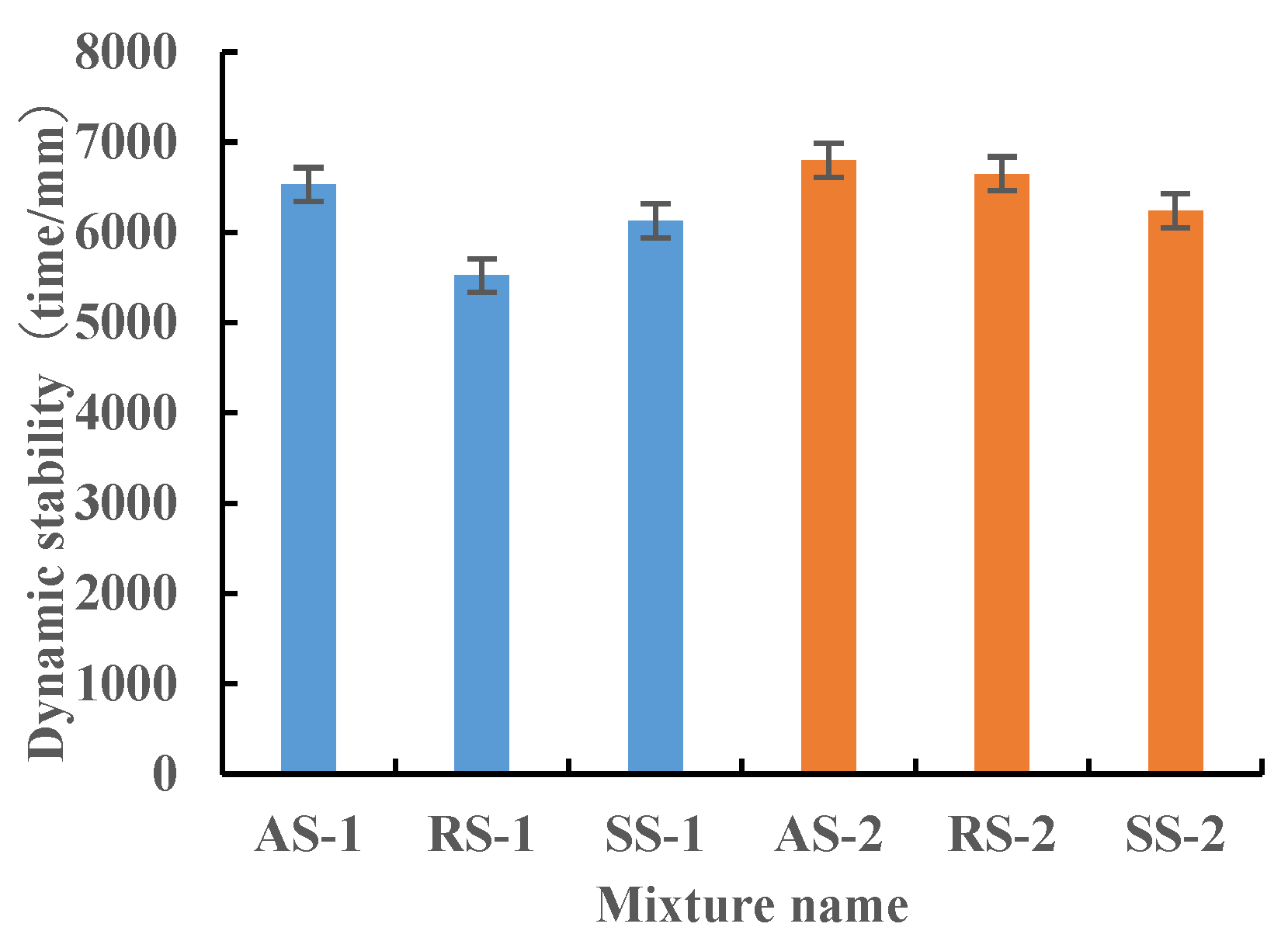

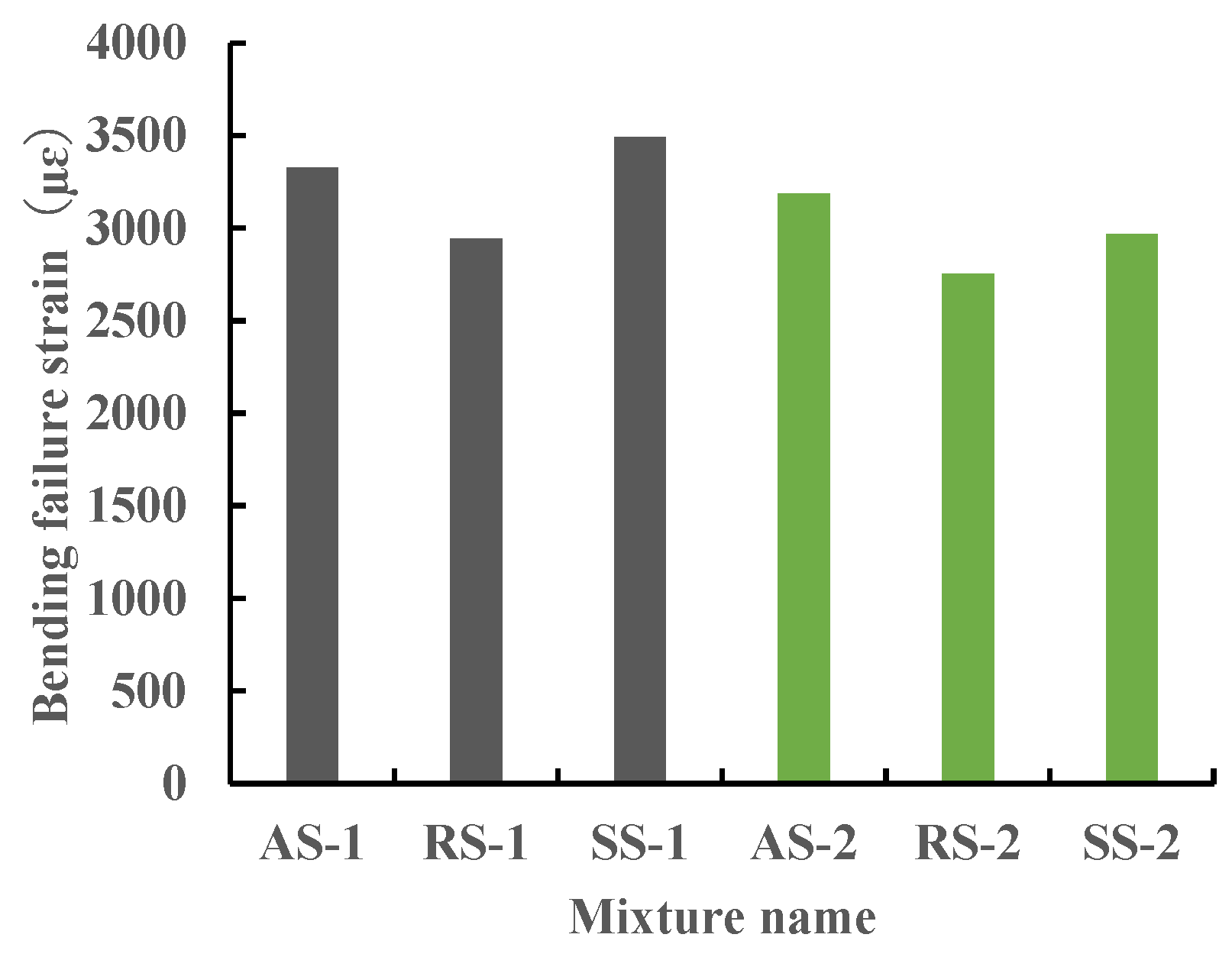
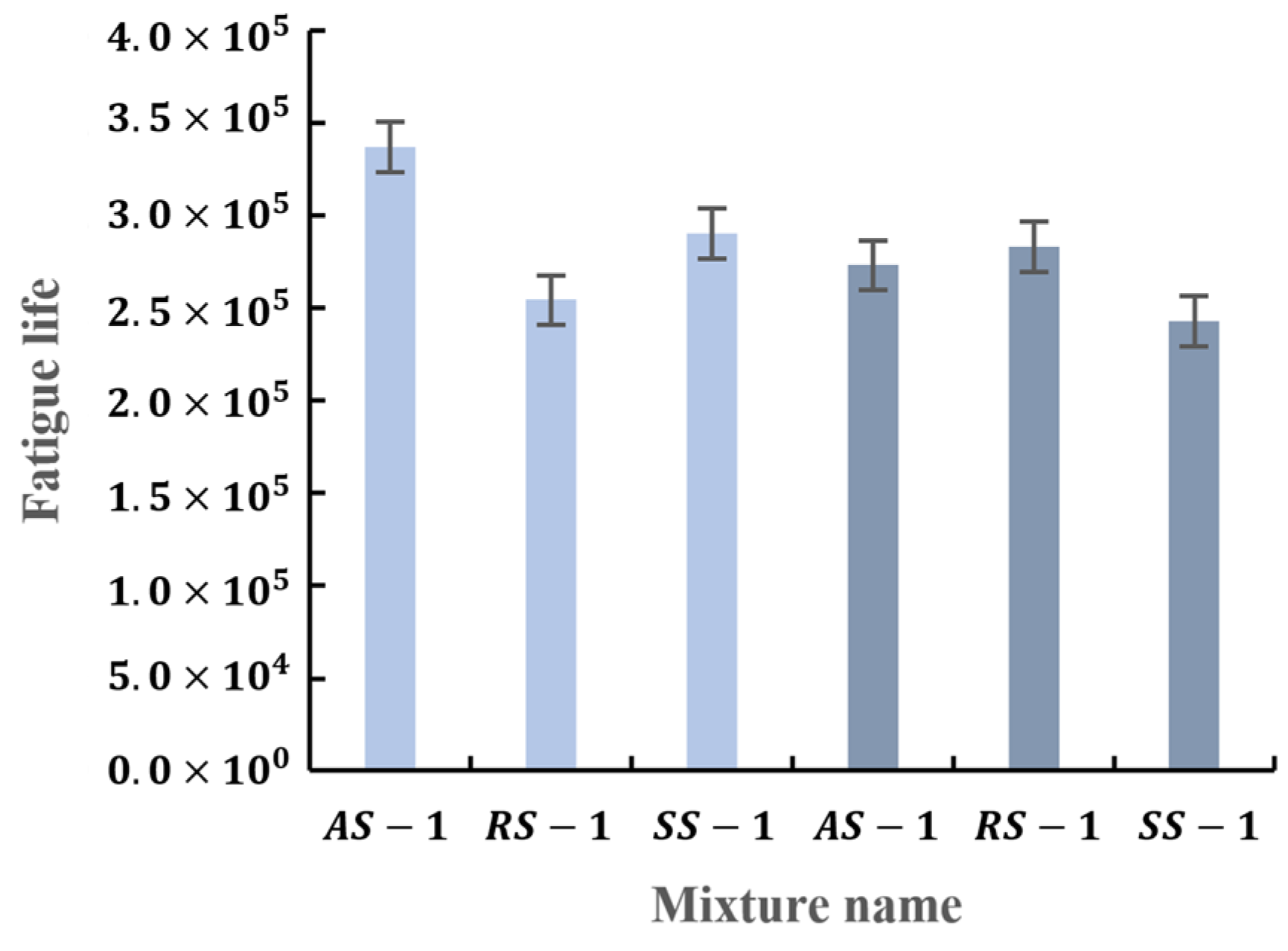
| Test Items | Measured Value | Coefficient of Variation (COV) (%) | Standard Value | |
|---|---|---|---|---|
| Penetration (25 °C, 100 g, 5 s, 0.1 mm) | 67 | 0.68 | 60~80 | |
| Ductility (15 °C, 5 cm/min, cm) | ≥100 | — | ≥100 | |
| Softening point (°C) | 49.6 | 1.92 | ≥45 | |
| Viscosity (135 °C, Pa·s) | 0.526 | 2.01 | — | |
| Rotating film aging test | Quality loss (%) | 0.31 | 3.23 | ≤0.8 |
| Penetration ratio (25 °C, %) | 78.2 | 1.05 | ≥61 | |
| Test Item | Ash Content (%) | Heat Loss (%) | Acetone Extract (%) | Rubber Hydrocarbon (%) |
|---|---|---|---|---|
| Test result | 7.1 | 0.45 | 10.3 | 51 |
| COV (%) | 2.82 | 5.88 | 1.68 | 1.96 |
| Name | Content of DRP (%) | Content of SBS (%) | Penetration (25 °C) (0.1 mm) | COV (%) | Softening Point (°C) | COV (%) | Ductility at 5 °C (cm) | COV (%) | Elastic Recovery (%) | COV (%) |
|---|---|---|---|---|---|---|---|---|---|---|
| DRS-1 | 20 | 0 | 48.3 | 0.7 | 62 | 1.6 | 7.7 | 9.4 | 90.2 | 0.7 |
| DRS-2 | 1 | 48 | 0.9 | 65.8 | 1.1 | 11.4 | 7.0 | 92.1 | 0.5 | |
| DRS-3 | 2 | 46.9 | 0.6 | 77.1 | 2.6 | 13.3 | 5.4 | 93.6 | 0.8 | |
| DRS-4 | 25 | 0 | 46.8 | 2.2 | 69.2 | 0.9 | 7.8 | 8.0 | 91.2 | 0.7 |
| DRS-5 | 1 | 44.7 | 1.2 | 75.5 | 0.5 | 11.7 | 9.9 | 93.4 | 0.6 | |
| DRS-6 | 2 | 47.1 | 1.1 | 82.5 | 1.2 | 14.6 | 7.8 | 94.2 | 0.7 | |
| DRS-7 | 28 | 0 | 45.6 | 1.1 | 71.3 | 2.6 | 7.4 | 7.2 | 92.1 | 0.8 |
| DRS-8 | 1 | 46.3 | 1.1 | 79.3 | 1.8 | 12.3 | 4.3 | 93.2 | 0.6 | |
| DRS-9 | 2 | 46.1 | 1.0 | 87.4 | 1.2 | 13.8 | 4.5 | 94.6 | 0.7 | |
| DRS-10 | 30 | 0 | 43.9 | 1.0 | 73.3 | 1.7 | 7.2 | 7.2 | 92.6 | 0.8 |
| DRS-11 | 1 | 47.1 | 1.0 | 82.7 | 3.6 | 12.6 | 4.4 | 93.4 | 0.9 | |
| DRS-12 | 2 | 48.7 | 2.1 | 89.4 | 1.0 | 14.7 | 5.4 | 93.8 | 0.7 |
| VTS Model Parameter | Content of DRP (%)-Content of SBS (%) | ||||||||||
|---|---|---|---|---|---|---|---|---|---|---|---|
| 25-0 | 28-0 | 30-0 | 20-1 | 25-1 | 28-1 | 30-1 | 20-2 | 25-2 | 28-2 | 30-2 | |
| A | 5.145 | 4.026 | 3.478 | 6.409 | 3.897 | 3.367 | 2.747 | 4.863 | 3.661 | 2.881 | 2.172 |
| VTS | 1.607 | 1.214 | 1.018 | 2.035 | 1.162 | 0.975 | 0.758 | 1.499 | 1.081 | 0.805 | 0.552 |
| Gradation | Passing Rate (%) | |||||||||
|---|---|---|---|---|---|---|---|---|---|---|
| 16 | 13.2 | 9.5 | 4.75 | 2.36 | 1.18 | 0.6 | 0.3 | 0.15 | 0.075 | |
| I | 100 | 98.3 | 82.6 | 56 | 34.4 | 23.5 | 17.9 | 10.1 | 6.4 | 4.5 |
| II | 100 | 96.8 | 67.1 | 32.4 | 24.5 | 18.5 | 15.4 | 10.7 | 8.4 | 6.8 |
| Name | DRP-SBS | RPA-SBS | SBS | |||
|---|---|---|---|---|---|---|
| Gradation I (AS-1) | Gradation II (AS-2) | Gradation I (RS-1) | Gradation II (RS-2) | Gradation I (SS-1) | Gradation II (SS-2) | |
| Optimal asphalt content (%) | 4.8 | 5.3 | 5.1 | 5.6 | 4.7 | 5.0 |
Disclaimer/Publisher’s Note: The statements, opinions and data contained in all publications are solely those of the individual author(s) and contributor(s) and not of MDPI and/or the editor(s). MDPI and/or the editor(s) disclaim responsibility for any injury to people or property resulting from any ideas, methods, instructions or products referred to in the content. |
© 2025 by the authors. Licensee MDPI, Basel, Switzerland. This article is an open access article distributed under the terms and conditions of the Creative Commons Attribution (CC BY) license (https://creativecommons.org/licenses/by/4.0/).
Share and Cite
Liu, B.; Zhang, K.; Fan, X.; Tu, C. Performance Evaluation of Desulfurized Rubber Powder and Styrene-Butadiene-Styrene Composite-Modified Asphalt. Coatings 2025, 15, 607. https://doi.org/10.3390/coatings15050607
Liu B, Zhang K, Fan X, Tu C. Performance Evaluation of Desulfurized Rubber Powder and Styrene-Butadiene-Styrene Composite-Modified Asphalt. Coatings. 2025; 15(5):607. https://doi.org/10.3390/coatings15050607
Chicago/Turabian StyleLiu, Bin, Kai Zhang, Xiangyang Fan, and Chongzhi Tu. 2025. "Performance Evaluation of Desulfurized Rubber Powder and Styrene-Butadiene-Styrene Composite-Modified Asphalt" Coatings 15, no. 5: 607. https://doi.org/10.3390/coatings15050607
APA StyleLiu, B., Zhang, K., Fan, X., & Tu, C. (2025). Performance Evaluation of Desulfurized Rubber Powder and Styrene-Butadiene-Styrene Composite-Modified Asphalt. Coatings, 15(5), 607. https://doi.org/10.3390/coatings15050607






